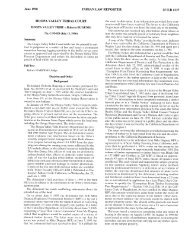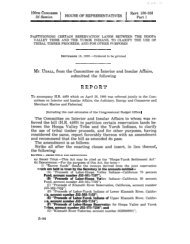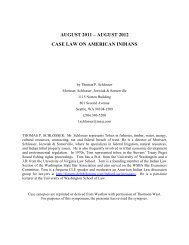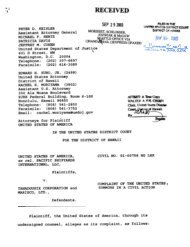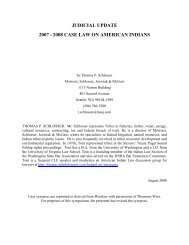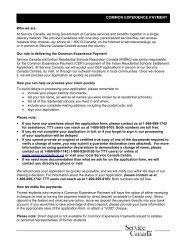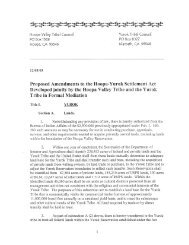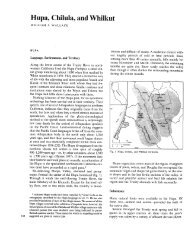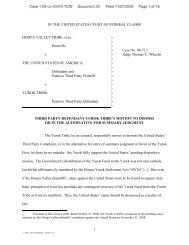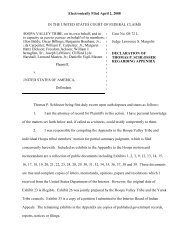Hoopa appendix supporting summary judgment - Schlosser Law Files
Hoopa appendix supporting summary judgment - Schlosser Law Files
Hoopa appendix supporting summary judgment - Schlosser Law Files
You also want an ePaper? Increase the reach of your titles
YUMPU automatically turns print PDFs into web optimized ePapers that Google loves.
Mr. <strong>Schlosser</strong>.<br />
16<br />
STATEMENT OF THOMAS SCHLOSSER<br />
Mr. SCHLOSSER. My name is Thomas <strong>Schlosser</strong>. I thank the committee<br />
for the opportunity of submitting testimony on the Secretary’s<br />
report.<br />
I have been honored to serve as the litigation counsel for the<br />
<strong>Hoopa</strong> Valley Tribe for over 20 years. During that time, I have represented<br />
the Tribe in the Short litigation and in the litigation concerning<br />
the Settlement Act.<br />
I have several points I would like to make. First, the Secretary’s<br />
report threatens a return to the situation the tribes were in prior<br />
to passage of the Settlement Act. The Settlement Act was necessitated<br />
by complex litigation among the United States, the <strong>Hoopa</strong><br />
Valley Tribe and a large number of individual Indians, most of<br />
whom but not all, have become members of the Yurok Tribe.<br />
The chairman mentioned the Karuk Tribe and there are a few<br />
members of the Karuk Tribe who were involved in the Short litigation<br />
and were held to be Indians of the reservation. It is a very<br />
small fraction of the Karuk Tribe, I would guess less than 10 percent.<br />
Whereas of the people who were held to be Indians of the reservation<br />
who elected to join the Yurok Tribe in 1991, the base roll<br />
of the Yurok Tribe was entirely made up of Indians of the reservation.<br />
There is another large fraction of Indians of the reservation that<br />
Mr. McCaleb referred to who chose to disaffiliate from both tribes,<br />
the so-called lump sum option under section 6(d). The Secretary’s<br />
report mistakes the Settlement Act as having primarily been a<br />
boundary resolution act and instead suggests that the settlement<br />
fund be administered for the mutual benefit of both tribes.<br />
Boundary clarification was only a small part of this act and the<br />
efforts to administer the fund for mutual benefit were dramatically<br />
unsuccessful prior to the Settlement Act. For years, long proceedings<br />
were necessary to get a tribal budget approved. Sometimes the<br />
tribal budget would get approved in the last month of the fiscal<br />
year because of Interior’s inability to adopt standards and to determine<br />
whether things affected the reservation fairly. This led to conflicts<br />
between rulings in the Short case and the Puzz case over<br />
which kinds of expenditures were permissible.<br />
For example, the Short case in 1987 held that money that was<br />
distributed to the tribe for tribal governmental purposes did not<br />
damage the Short plaintiffs, was not an injury to the Indians of the<br />
reservation and did not invade their rights. The Puzz court, a district<br />
court in the Northern District of California, held to the contrary,<br />
that funds used by the <strong>Hoopa</strong> Valley Tribe did damage the<br />
Indians of the reservation. So there are insufficient standards and<br />
not enough expertise to make that recommendation work well. As<br />
George Santayana said, ‘‘Those who cannot remember the past are<br />
condemned to relive it.’’ There is an error found in Interior’s recommendation.<br />
Under the Settlement Act, there are some benefits potentially<br />
available to the <strong>Hoopa</strong> Valley and Yurok Tribes. Only 22 Short<br />
plaintiffs were adjudicated to be Indians of the reservation in 1973,<br />
so the court embarked on a long process which actually is still un-



